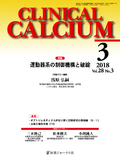Japanese
English
- 有料閲覧
- Abstract 文献概要
- 1ページ目 Look Inside
- 参考文献 Reference
運動器の中でも骨格筋は,全身の代謝を考える上でも重要な役割を果たしており,特にグルコースの取り込みにおける寄与は体内で最大である。インスリンは骨格筋においても栄養素の同化を促進し,またインスリン様成長因子1(IGF-1)と共に骨格筋量を増加させる方向で作用する。一方でヒトにおいては,加齢に伴い骨格筋でインスリン抵抗性が惹起され,それが全身のインスリン抵抗性につながっている可能性があり,また血中IGF-1濃度も加齢に伴って低下する。両者が相まって,骨格筋の量と機能が障害されたサルコペニアにつながっているものと考えられ,逆にインスリン/IGF-1シグナルを適切に修飾することで,サルコペニアの治療につながる可能性も提唱されている。
Among the tissues involved in the motor system, skeletal muscle plays an important role in systemic metabolism and is the largest organ in terms of glucose uptake. Insulin promotes anabolism of nutrients in skeletal muscle, as in other insulin-targeted organs, and maintains muscle volume, in cooperation with insulin-like growth factor-1. In humans, along with aging, insulin resistance is induced in skeletal muscle, which could lead to systemic insulin resistance, and circulating IGF-1 levels are lowered. These changes contribute to the development of sarcopenia, in which function and volume of skeletal muscle are impaired, and modulation of the insulin/IGF-1 signaling could be promising in treatment of sarcopenia.



